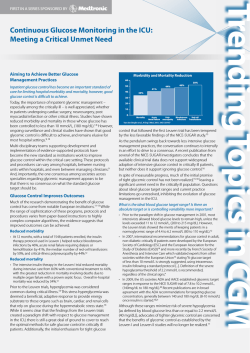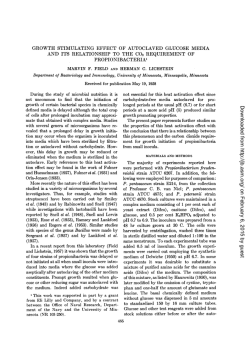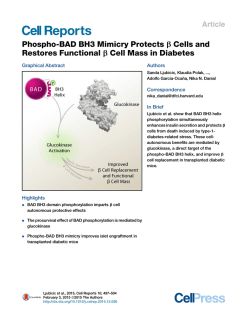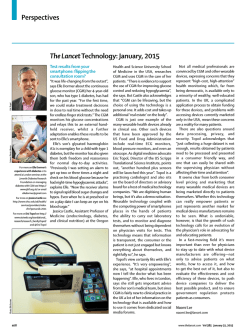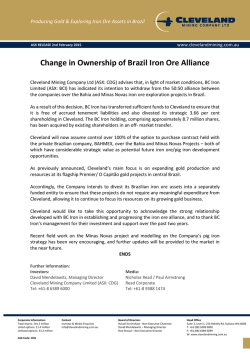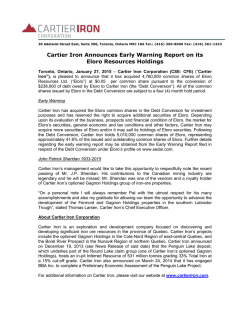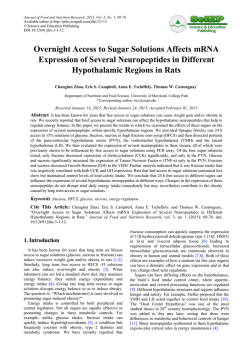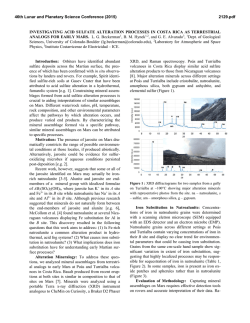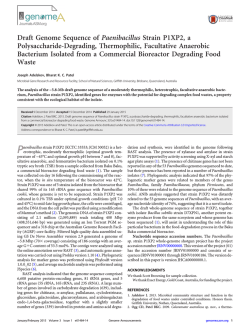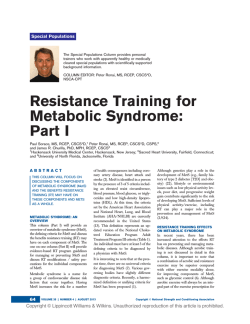
Glucose Transport System in a Facultative Iron
Vol. 150, NO. 3 JOURNAL OF BACTERIOLOGY, June 1982, p. 1109-1114 0021-9193/8V061109-06$02.00 Glucose Transport System in a Facultative Iron-Oxidizing Bacterium, Thiobacillus ferrooxidans TSUYOSHI SUGIO,* SHINICHI KUDO, TATSUO TANO, AND KAZUTAMI IMAI Department of Agricultural Chemistry, Faculty ofAgriculture, Okayama University, Okayama 700, Japan Received 16 November 1981/Accepted 25 January 1982 Properties of a heat-labile glucose transport system in Thiobacillusferrooxidans strain AP-44 were investigated with iron-grown cells. [14C]glucose was incorporated into ceil fractions, and the cells metabolized [14C]glucose to 14CO2. Amytal, rotenone, cyanide, azide, 2,4-dinitrophenol, and dicyclohexylcarbodiimide strongly inhibited [14C]glucose uptake activity, suggesting the presence of an energy-dependent glucose transport system in T. ferrooxidans. Heavy metals, such as mercury, silver, uranium, and molybdate, markedly inhibited the transport activity at 1 mM. When grown on mixotrophic medium, the bacteria preferentially utilized ferrous iron as an energy source. When iron was exhausted, the cells used glucose if the concentration of ferrous sulfate in the medium was higher than 3% (wt/vol). However, when ferrous sulfate was lower than 1%, both of the energy sources were consumed simultaneously. Thiobacillus ferrooxidans has been classified as a strict autotroph (15). However, Shafia et al. (5, 6) and Tabita and Lundgren (11) have shown that when autotrophically grown cells are transferred to a medium containing iron plus glucose, cells preferentially utilize ferrous iron, and when the iron is exhausted, they use glucose. These glucose-adapted cells can grow on glucose as the sole energy source upon transfer into a glucosesalts medium. Some conditions for adaptation and the enzymes involved in glucose metabolism have been studied by several workers (5, 6, 1113). Recently, Harrison et al. (2) isolated a pair of stable phenotypes from several presumably pure cultures of T. ferrooxidans. One phenotype was a strict autotroph utilizing sulfur or ferrous iron as the energy source and was unable to utilize glucose; the other phenotype was an acidophilic obligate heterotroph capable of utilizing glucose but not sulfur or ferrous iron. From the results of studies of DNA homology, it was concluded that the acidophilic heterotroph was of a different genotype from that of, T. ferrooxidans or T. acidophilus (1), and the authors warned that the cultures of T. ferrooxidans reported to be capable of utilizing organic compounds should be carefully examined for contamination. We have also isolated two kinds of ironoxidizing bacteria from our culture of irongrown T. ferrooxidans strain SPP (8). One (strain AP-19) was a strict autotroph utilizing ferrous iron or sulfur as the energy source and was unable to utilize glucose or organic substances; the other (strain AP-44) was a facultative iron-oxidizing bacterium which obtains its energy from ferrous iron or elemental sulfur in addition to organic substances, such as glucose, galactose, gluconic acid, citric acid, peptone, and yeast extract. The most distinct physiological difference between these strains was their ability to take up [14C]glucose into the cells. The problem of whether there is a facultative strain of iron-oxidizing T. ferrooxidans which can use ferrous iron, sulfur compounds, and organic substances as the energy sources has not yet been established. In this paper, the [t4Clglucose uptake system of iron-grown AP-44 was studied to clarify whether the system operated in glucose metabolism of this bacterium. MATERIALS AND METHODS Microorganism. The iron-oxidizing bacterium, T. ferrooxidans strain AP-44 (8) was used throughout this study. Media and conditions of cultivation. The organism was grown on three media: (i) 9K medium (7), which contained ferrous iron as the sole energy source; (ii) iron-glucose medium, which contained glucose added to the 9K medium and was used for mixotrophic growth; (iii) glucose-salts medium, which contained 0.5% glucose and salts of 9K medium (excluding ferrous sulfate) and was used for heterotrophic growth. In the growth experiments, 100 ml of the ironglucose medium described above was inoculated with 2 ml of an autotrophically grown culture and shaken at 28°C. The method used for large-scale production of 1109 1110 SUGIO ET AL. autotrophically grown cells, which was used for the measurement of [14CJglucose uptake, was that described earlier (10). Growth rate. All cultures were filtered through Toyo ifiter paper no. 5C and diluted to the required level with 0.1 N sulfuric acid. The growth rate was determined by direct cell counts of the ifitrate with a Thomas counting chamber. Ferrous iron and glucose determination. The determination of ferrous iron or glucose concentration in the medium was as described previously (8). [14CJglucose uptake activity. The radioactivity of [U'4C]glucose taken up by iron-grown strain AP-44 or glucose-salts-grown strain AP-44 was measured by the method previously described (8). The composition of the reaction mixture was as follows: 2 ml of 0.1 M Palanine sulfurfc acid buffer, pH 3.0; log-phase cells which were washed three times with 0.01 M phosphate buffer, pH 7.5 (20 mg of protein); carrier glucose, 2 ,umol; [U-14C]glucose, 1.2 pCi. Total volume was 4.5 ml. Each of the metabolic inhibitors tested was added to the reaction mixture. The reaction mixture, except glucose, was incubated at 30°C for 10 min before addition of glucose. The reaction was stopped by adding 0.5 ml of 20 mM mercuric chloride. The reaction mixture was immediately centrifuged at 14,000 x g for 10 min, and the cells were washed twice with 10 ml of distilled water. The radioactivity of the washed cells was determined by using an Aloka LSC-635 liquid scintillation system. The counting vial contained 2 ml of the washed cell suspension (4 mg of protein) plus 4 ml of counting mixture consisting of PCS (Amersham Corp.) (total volume, 6 ml). Counting efficiency was measured by the external standard method. The amount of glucose taken up was expressed in terms of micromoles per milligram of protein. Distbution of [14Cjglucose in the edls. Iron-grown cells were treated with [U-14C]glucose for 1 h in the following reaction mixture: 54 ml of 0.1 M ,B-alanine sulfuric acid buffer, pH 3.0; iron-grown cells (725 mg of protein); carrier glucose, 20 ,umol; [U-14C]glucose, 12 MCi. Total volume was 100 ml. The reaction was stopped by adding 10 ml of 20 mM mercuric chloride, and the cells were washed immediately four times with 90 ml of distilled water. The [U-14C]glucose-treated cells were disrupted by sonic oscillation (20 kHz) for 30 min. The broken cells were centrifuged at 10,000 x g for 20 min. The crude extract was further centrifuged at 105,000 x g for 60 min to separate the particulate fraction (plasma membrane fraction) and supernatant fraction (cytosol fraction). The radioactivity of each fraction was determined by using the liquid scintillation system and the method as described above. I4Co2 evolution. 14CO2 evolved from the [U-14C]glucose-treated cells was trapped into a pair of tubes containing 10 ml of monoethanolamine, using the method and the apparatus previously described (8). The composition of the reaction mixture was as follows (experiment A): 3.0 ml of 0.1 M P-alanine sulfuric acid buffer, pH 3.0; iron-grown cells (20 mg of protein); carrier glucose, 2 pLmol; [U-14C]glucose, 1.2 uCi. Total volume was 5.0 ml. The same concentration of a 10-min boiled fraction was also used to determine the amount of 14CO2 evolution (experiment B). The reaction was stopped after 30 min by adding 0.5 ml of 20 mM mercuric chloride. The radioactivity trapped in J. BACTERIOL. monoethanolamine was determined by using the method described above. Protein determination. The protein content was determined by the biuret method (3), using crystalline bovine serum albumin as the reference protein. RESULTS Distbution of the radioacftvity in iron-grown cells after the icorporation of [14Ciglucose. The time course of [14C]glucose uptake into irongrown cells is shown in Fig. 1. The level of radioactivity increased with time, and the profile of the curve was similar to that obtained with glucose-salts-grown cells (8). The [14C]glucose uptake activity was nearly completely destroyed by heating the cells in a water bath at 70°C for 10 min. To distinguish whether [14C]glucose is taken up into the cells or merely attached tightly on the surface of the outer membrane, a study of the distribution of the radioactivity in the irongrown cells was carried. As shown in Table 1, a large amount (52.3%) of the radioactivity taken up into the cells was in the cytosol fraction, suggesting that [14C]glucose is taken up into the iron-grown cells. 14CO2 evolution of iron-grown strain AP44. The amount of 14CO2 evolved from the [14C]glucose-treated iron-grown cells was determined by trapping 14CO2 into monoethanolamine. As shown in Table 2, significant 14CO2 evolution occurred with intact cells, in contrast to the controls with boiled cells. Similar results were also obtained for glucose-salts-grown strain AP44 (8). The results suggest that [14C]glucose is c 0 3 . 0 E 0 E 0.to I 0 0 o 60 30 Time (min) FIG. 1. Time course of [U-14C]glucose uptake into iron-grown cells. The method for analysis and the composition of reaction mixture were described in the text. TABLE 1. Distribution of the radioactivity in the cells of iron-grown T. ferrooxidans strain AP-44 after the incorporation of [U-14C]glucose Fraction' 1111 GLUCOSE TRANSPORT IN T. FERROOXIDANS VOL. 150, 1982 Prtein (m) Total adctiity (cpm) Distri- bution (% 79.6 482 1,037,294 Cell-free crude extract 260 266,200 20.4 Cell debris 162 682,789 52.3 Cytosol fraction 238 390,443 29.9 Plasma membrane fraction a Each of the fractions was prepared from [U14C]glucose-treated cells by the method described in the text. The washed cells before fractionation contained 1,201,018 cpm total radioactivity. not only taken up into the cells, but is also metabolized to carbon dioxide and water. Effect of various Inhibitors on [14C1glucose uptake activity. Table 3 shows that [1 C]glucose uptake activity was strongly inhibited by several respiratory inhibitors or uncoupling reagents, such as amytal, rotenone, cyanide, azide, 2,4dinitrophenol, and dicyclohexylcarbodiimide, in both iron-grown cells and glucose-salts-grown cells. Heavy metals, such as mercury, silver, uranium, and molybdate, also markedly inhibited the [(4C]glucose transport activity in both iron-grown cells and glucose-salts-grown cells. Figure 2 shows the effects of ferrous and ferric iron on the [14C]glucose uptake activity. The activity of iron-grown cells was markedly inhibited by ferrous iron but not by ferric iron at similar concentrations. Similar results were obtained for glucose-salts-grown cells. We usually observed that when the bacterium was grown mixotrophically (iron-glucose medium), cells preferentially utilized ferrous iron as an energy source if the concentration of ferrous TABLE 3. Effect of respiratory inhibitors and uncoupling reagents on [14C]glucose uptake activity [14C]glucose uptake activity (103 ,umol/mg of protein) Compound4 Final concn (M) GlucoseIrongrown None Amytal Rotenone Quinacrine Progesteron Cyanide 5 x 10-5 5 x 10-5 lo-3 10-3 10-4 lo-3 10-4 lo-3 Azide grown cells cells 1.17 0.00 0.00 0.91 0.94 0.64 0.07 0.82 0.00 0.14 0.00 1.92 0.00 0.00 1.71 1.79 0.28 0.65 10-3 0.18 2,4-DNP 5 x 10-5 0.00 DCCD a DCCD, Dicyclohexylcarbodiimide; 2,4-DNP, 2,4dinitrophenol. sulfate in the medium was higher than 10 mM, and when the ferrous iron was exhausted, they utilized glucose (Fig. 3). The same phenomenon was also observed by Tabita and Lundgren (11). If the concentration of ferrous iron in the medium was below 3.5 mM, cells utilized both ferrous iron and glucose at the same time (Fig. 4). The reason why the bacterium was not able to utilize glucose at the early stage of growth in high-iron mixotrophic medium is well explained by the properties of the [14C]glucose transport c 0. 1.5k -E 0 x TABLE 2. "CO2 evolution from ['4C]glucose- incorporated iron-grown cells Radioactivity (cpm) Fraction Expt Bb Expt Al 620 30,735 Cells Respiratory "CO2c 3 670 Flask 1 4 4 Flask 2 a Results obtained with intact iron-grown cells. " Results obtained with 10-min boiled iron-grown cells. c CO2 evolved from the [U-14C]glucose-treated cells was trapped into a pair of flasks containing 10 ml of monoethanolamine; flasks 1 and 2 were connected to the reaction vessel successively. The method for analysis and the composition of reaction mixture were described in the text. in Go 1.0 # 0 EGD - 40 a *n 3 0.5 . 0 0 10 10-3 1-2 10-1 Concentration (M) FIG. 2. Effect of ferrous iron and ferric iron on [Uuptake activity of iron-grown cells. The method for analysis and the composition of reaction mixture were described in the text. Symbols: 0, ferrous iron; 0, ferric iron. 14C]glucose SUGIO ET AL. 1112 J. BACTERIOL. 7 6E E . E GD V ._ 10 0 E EED to E 0p 5E 40' to GD E 1- E (A 38In iZ ct IL. cm U. 2. 0 lo 0 u U I0 0 2 4 6 8 Time (days) 10 FIG. 3. Growth of T. ferrooxidans strain AP-44 on 5% ferrous sulfate-0.5% glucose-salts medium. The composition of the medium and the method for cultivation were described in the text. Symbols: 0, cell growth; A, concentration of ferrous iron; *, concentration of glucose. system. Since at the initial stage of growth shown in Fig. 3, 18 mM of ferrous iron in the medium strongly inhibited glucose uptake into the cells, the organism utilized ferrous iron first. However, when ferrous iron was oxidized to ferric iron, the condition of the medium became preferable for the organism to utilize glucose, and in this way, ferrous iron concentration controls the utilization of glucose. DISCUSSION The following properties are required to show that strain AP-44 is a facultative iron-oxidizing bacterium: (i) glucose in the medium must be taken up into the cells; (ii) glucose taken up must be metabolized to carbon dioxide and water, and energy must be generated from the reaction; (iii) the metabolism of glucose must be satisfied with iron-grown cells. There have been few reports about glucose uptake in iron-grown T. ferrooxidans. Tuovinen and Kelly (14) have shown that suspensions of T. ferrooxidans incorporated a small amount of 14C-labeled glucose when incubated in its presence at pH 2.0 in Warburg flasks. The amount of [U-14C]glucose incorporated was dependent on the presence offerrous iron, and the activity was increased about 2.5-fold by adding 60 ,umol of ferrous iron. In contrast, we found that the activity in iron-grown strain AP-44 was independent of the presence of ferrous iron; rather, it was markedly inhibited by high concentrations of the ions. Tuovinen and Kelly (14) did not discuss whether the incorporated glucose was utilized as the energy source or as the carbon source. Matin et al. (4) reported that 2-deoxy-D-glucose uptake activity by washed cell suspensions of T. novellus, which is a facultative sulfuroxidizing bacterium, was inhibited by azide, cyanide, and 2,4-dinitrophenol. We also observed heat-labile and energy-dependent [14C]glucose uptake in iron-grown T. ferrooxidans strain AP-44 and propose that the system plays an important role on the glucose metabolism of this bacterium for the following reasons: (i) strain AP-19, which does not have any [14C]glucose uptake activity, could not utilize glucose for energy and carbon source (8), but the cell-free crude extract of iron-grown AP-19 had a level of glucose-metabolizing activity similar to that of iron-grown strain AP-44; (ii) 52.3% of the total radioactivity taken up into the cells of strain AP-44 as [14C]glucose was found to be distributed in the cytosol fraction; (iii) 14CO2 evolution was observed from [14C]glucose with iron-grown cells, and the reaction was very sensitive to cyanide or azide, suggesting an 7 6 E E E 40 E E E 3:E .; i E 01 to = E 2'9 IL*U- U v 0 0 o 23'CWa% u 0 0- I c 0 uI 4 3 2 Time (days) v o 0 JO FIG. 4. Growth of T. ferrooxidans strain AP-44 on 1% ferrous sulfate-0.5% glucose-salts medium. The composition of the medium and the method for cultivation were described in the text. Symbols: 0, cell growth; A, concentration of ferrous iron; *, concentration of glucose. GLUCOSE TRANSPORT IN T. FERROOXIDANS VOL. lS0, 1982 involvement of a terminal electron transport system in the reaction; (iv) the properties of [ 4C]glucose uptake in iron-grown cells were similar to those of glucose-salts-grown cells; (v) the pH optimum of ["4C]glucose uptake activity (pH 3.0 in both iron-grown strain AP-44 and glucose-salts-grown AP-44) closely corresponded with that for growth on glucose-salts medium (pH 2.5 to 3.0); (vi) the reason why the bacterium was not able to utilize glucose at the early stage of growth in the high-iron mixotrophic medium is well explained by the properties of the [14C]glucose transport system. The physiological and enzymatic data obtained in our laboratory (8-10) also suggest the existence of a facultative iron-oxidizing bacterium. We observed activities of enzymes or an enzyme system involved in glucose metabolism, such as glucose-oxidizing activity, glucose dehydrogenase, and NADH oxidase (NADH:acceptor oxidoreductase), in glucose-salts-grown cells and also in iron-grown cells. From DNA homology, Harrison et al. (2) warned that cultures of T. ferrooxidans reported to be capable of utilizing organic compounds should be carefully examined for contamination. They proposed that it is possible that the contaminants, such as acidophilic heterotrophic thiobacilli or acidophilic obligate heterotrophs, utilize trace amounts of organic substances from the atmosphere of the incubation chamber or as impurities on the inorganic ingredients in the medium. If the contaminant cells utilize the organic E .2 1113 substances described above, the amount of cells obtained must be negigibly small as compared with the autotrophically grown T. ferrooxidans on 9K medium. We observed that iron-grown T. ferrooxidans remained viable for a long time without autolysis. Thus, only small numbers of contaminant cells could be grown by utilizing autolyzed organic substances for the energy and carbon source after the stationary phase of the bacterium. A negligibly small amount of contaminant cells would be present at the early stage of cultivation because iron-grown cells were always harvested at the late logarithmic stage of growth after 5 or 6 days of cultivation. The most reliable way to check homogeneity of the facultative iron-oxidizing bacterium strain AP-44 may be to obtain a single colony on a glucose agar plate and to prove whether the isolated organism can grow on autotrophic media or heterotrophic media. We tried to make a single colony on the glucose agar plate. The most desirable glucose agar plate for the purpose was found to be 0.5% ferrous sulfate-0.5% glucose-1.00o agar-salts (pH 3.5). Isolated, tiny brown opaque colonies were obtained on the plate. After 1 or 2 days of cultivation on the plate, the agar turned to yellow, suggesting the formation of ferric hydroxide. The isolation on the plate described above was repeated five times, and each of the finally isolated colonies was maintained on an agar slant of the same composition. Figure 5 shows cells from a single colony grown on autotrophic media or glucose-yeast X1082 E v (a 0 U _ 1 0I. c 0 2 4 6 10 Time (days) FIG. 5. Growth of a single colony obtained on a ferrous-glucose-salts-agar plate from strain AP-44 on autotrophic, mixotrophic, and heterotrophic media. The methods for isolation and maintenance were described in the text. Symbols: *, 5% ferrous sulfate-salts medium (9K medium); 0, 5% ferrous sulfate-0.5% glucosesalts medium; A, 0.5% glucose-salts medium; 0, 0.5% glucose-0.1% yeast extract-salts medium. 1114 SUGIO ET AL. extract media. The organism could not grow on glucose-salts medium, suggesting the requirement of some growth factor(s). In contrast, it could grow on ferrous sulfatoeglucose salts medium without growth factor(s). ACKNOWLEDGMENT We aclmowledge the many hdpful discussions with K. Hachiya regarding the radiorespirometric experments. LITERATURE CITED 1. Guay, R., and M. Slm. 1975. Thiobacillus acidophilus sp. nov.; isolation and some physiological characteristics. Can. J. Microbiol. 21:281-288. 2. Hawrko, A. P., Jr., B. W. J1vis, adJ. L. Johnon 1980. Heterotrophic bacteria from cultures of autotrophic Th1obacillusferooxidans: relationship as studied by means of deoxyribonucleic acid homology. J. Bacteriol. 143:448454. 3. Layne, E. 1957. Spectrophotometric and turbidmetric methods for measuring proteins. Methods Enzymol. 3:447-454. 4. Matn, A., M. Sdceks, ad R. C. Perz. 1980. Regulation of glucose transport and metabolism in Thiobacilus novellus. J. Bacteriol. 142:639644. 5. Shah, F., t. IL BDe., M. W. p_nzm, and J. M. Brady. 1972. Tnition of the chemolithotroph Ferrobacillusferrooxidans to obfigate organotrophy and metabolic capabilities ofglucose-grown cells. J. Bacteriol. 111:56- 65. 6. Shaa, F., and R. F. Wilknson, Jr. 1961. Growth of J. BACTERIOL. Ferrobacillus ferrooxidans on organic matter. J. Bacteriol. 97:256-260. 7. Sllver , M. P., and D. G. LIadmn . 1959. Studies on the chenoautotrophic iron bacterium Ferrobacilus ferrooxidans. J. Bacteriol. 77:642-47. 8. Sqol, T., Y. Anza, T. Tano, and K. Inua. 1981. Isolation and some properties of an obligate and a facultative ironoxidizing bacteria. Agric. Biol. Chem. 45:1141-1151. 9. Sqlo, T., T. Tano, nd K. Ihal. 1981. Isolaton and some p ies of slver ion-resistant iron-oxidizing bacterium ThiobaciUus ferrooxidans. Agric. Biol. Chem. 45:20372051. 10. Sinl. T., T. Tan, and K. Inad. 1981. Isolation and some properties of two kinds of cytochrome c oxidase from iron-grown Thiobacilusferrooxidans. Agric. Biol. Chem. 45:1791-1799. 11. Tabita, R., and D. G. LIngX. 1971. Utization of glucose and the effect of organic compounds on the chemolithotroph Thiobacillus ferrooxidans. J. Bacteriol. 106:328-333. 12. Tablt, R., and D. G, LIani . 1971. Heterotrophic metabolism of the chemolithotroph Thiobacifuseffrrooxidans. J. Bacteriol. 108:334-342. 13. Tabita, R., and D. G. Laigren. 1971. Glucose-6-phosphate dehydrogenase from the chemolithotroph Thiobacillusferroaxidans. J. Bacteriol. 106:343-352. 14. TuovIn, 0. H., and D. P. Kelly. 1974. Studies on the growth of ThiobaciUus ferrooxidans. Arch. Microbiol. 95:165-180. 15. Vihadac, W. V. 1974. Thiobacillus beUerinck 1904, 597, p. 460. In R. E. Buchanan and N. E. Gibbons (ed.), Berey's manual of determinative bacteriology, 8th ed. The Williams & Wilkins Co., Baltimore.
© Copyright 2025
